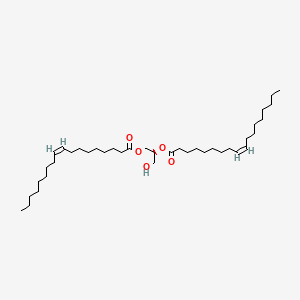1,2-Dioleoyl-sn-glycerol
1,2-Dioleoyl-sn-glycerol is a lipid of Glycerolipids (GL) class. 1,2-dioleoyl-sn-glycerol is associated with abnormalities such as SAPOSIN D (disease) and Exanthema. The involved functions are known as Energy Transfer, Increased Sensitivy, Chelating Activity [MoA], protein kinase C activity and Phosphorylation. 1,2-dioleoyl-sn-glycerol often locates in vesicle, Tissue membrane, Membrane, viral nucleocapsid location and Protoplasm. The associated genes with 1,2-Dioleoyl-sn-glycerol are SIGLEC12 gene, Genome, RNF7 gene, FANCL gene and TNFRSF11B gene. The related lipids are Unilamellar Vesicles, diolein, Phosphatidylserines, Fatty Acids and monoolein.
References related to lipids published in J. Biol. Chem.
| PMID | Journal | Published Date | Author | Title |
|---|---|---|---|---|
| 8617724 | J. Biol. Chem. | 1996 | Slater SJ et al. | Protein kinase Calpha contains two activator binding sites that bind phorbol esters and diacylglycerols with opposite affinities. |
| 7592722 | J. Biol. Chem. | 1995 | Mosior M and Newton AC | Mechanism of interaction of protein kinase C with phorbol esters. Reversibility and nature of membrane association. |
| 9388229 | J. Biol. Chem. | 1997 | Antonny B et al. | Activation of ADP-ribosylation factor 1 GTPase-activating protein by phosphatidylcholine-derived diacylglycerols. |
| 9705304 | J. Biol. Chem. | 1998 | Ahn T and Kim H | Effects of nonlamellar-prone lipids on the ATPase activity of SecA bound to model membranes. |
| 14665624 | J. Biol. Chem. | 2004 | Gómez-Merino FC et al. | AtDGK2, a novel diacylglycerol kinase from Arabidopsis thaliana, phosphorylates 1-stearoyl-2-arachidonoyl-sn-glycerol and 1,2-dioleoyl-sn-glycerol and exhibits cold-inducible gene expression. |
| 15364929 | J. Biol. Chem. | 2004 | Jenkins CM et al. | Identification, cloning, expression, and purification of three novel human calcium-independent phospholipase A2 family members possessing triacylglycerol lipase and acylglycerol transacylase activities. |
| 16081412 | J. Biol. Chem. | 2005 | Gómez-Merino FC et al. | Arabidopsis AtDGK7, the smallest member of plant diacylglycerol kinases (DGKs), displays unique biochemical features and saturates at low substrate concentration: the DGK inhibitor R59022 differentially affects AtDGK2 and AtDGK7 activity in vitro and alters plant growth and development. |
